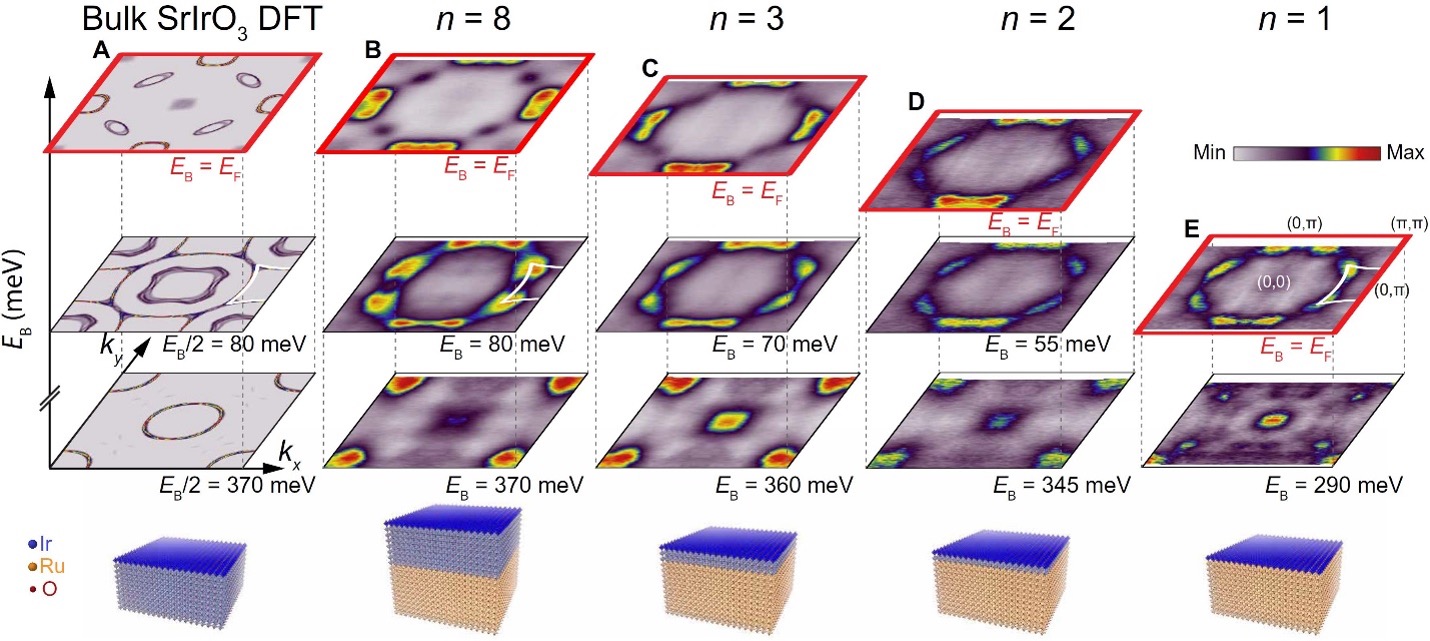PARADIM Highlight #60—In-House Research (2022)
Kyle M. Shen, Darrell G. Schlom, Lena F. Kourkoutis (Cornell University)
Ultrathin quantum materials present a unique platform for the control of electronic, magnetic, and topological properties. A commonly observed phenomenon in many ultrathin quantum materials is that an undesired crossover from a metallic to insulating state occurs below a critical thickness. This presents a potential challenge for realizing ultrathin heterostructures of quantum materials when metallic properties are desired.

Figure 1:Constant energy intensity ARPES maps of (SrIrO3)n/(SrRuO3)20 heterostructures and comparison with density functional theory (DFT) calculations of constant energy intensity maps for bulk SrIrO3 at a variety of binding energies.
Here, members of PARADIM’s In-House Research Group use angle-resolved photoemission spectroscopy (ARPES) and molecular-beam epitaxy (MBE) to reveal the electronic structure, charge transfer, doping profile, and carrier effective masses in a layer-by-layer fashion for the interface between the Dirac nodal-line semimetal SrIrO3 and the correlated metallic Weyl ferromagnet SrRuO3.
It is shown here that metallicity can be preserved even down to a single SrIrO3 layer, due to the structural similarities between SrIrO3 and SrRuO3, and the overlapping iridium and ruthenium d orbitals. In addition, ARPES reveals that electrons are transferred from the SrIrO3 layer into the SrRuO3, with an estimated screening length of λ = 3.2 ± 0.1 Å.

Figure 2: High-angle annular dark-field scanning transmission electron microscopy (HAADF-STEM) images of n = 1 and 2 heterostructures measured along the [100]p direction, where p indicates the pseudocubic basis. This shows precise heterostructures with smooth and abrupt interfaces and with the SrIrO3 layers terminated by the expected SrO layer. Samples were capped with either amorphous Al2O3 or crystalline SrTiO3 following ARPES measurements but before removal from UHV.
Interface quantum materials have yielded a plethora of previously unknown phenomena, including unconventional superconductivity, topological phases, and possible Majorana fermions. Typically, such states are detected at the interface between two insulating constituents by electrical transport, but when either material is conducting, transport techniques become insensitive to interfacial properties. To overcome these limitations, angle-resolved photoemission spectroscopy and molecular-beam epitaxy are used to reveal the electronic structure, charge transfer, doping profile, and carrier effective masses in a layer-by-layer fashion for the interface between the Dirac nodal-line semimetal SrIrO3 and the correlated metallic Weyl ferromagnet SrRuO3. It is found that electrons are transferred from the SrIrO3 or SrRuO3, with an estimated screening length of λ = 3.2 ± 0.1 Å. In addition, metallicity is preserved even down to a single SrIrO3 layer, where the dimensionality-driven metal-insulator transition typically observed in SrIrO3 is avoided because of strong hybridization of the Ir and Ru t2g states.
While state-of-the-art synthesis methods have enabled the synthesis of ultrathin quantum materials down to a single unit cell, that is often accompanied with undesired effects, such as a change in their properties from metallic to insulating, something that could limit their potential usefulness in future devices. Here, we demonstrate that we are able to retain metallicity in a single-unit-cell-thick layer of SrIrO3 grown on another quantum material, SrRuO3. Due to a combination of their structural similarity and also the compatible orbital overlap between the Ru and Ir d orbitals, we find that we are, in fact, able to enhance (rather than destroy) the metallicity of a single unit cell of SrIrO3 when compared to the bulk.
This work was made possible by PARADIM's unique combination of state-of-the-art materials synthesis that enabled the synthesis of SrIrO3 / SrRuO3 heterostructures with a high degree of perfection, and in-situ ARPES spectroscopy that allowed the detection of the persistent metallicity of a single layer of SrIrO3 on SrRuO3.
The work was performed by members of the PARADIM In-House Research Group.
J.N. Nelson, N.J. Schreiber, A.B. Georgescu, B.H. Goodge, B.D. Faeth, C.T. Parzyck, C. Zeledon, L.F. Kourkoutis, A.J. Millis, A. Georges, D.G. Schlom, and K.M. Shen, "Interfacial Charge Transfer and Persistent Metallicity of Ultrathin SrIrO3/SrRuO3 Heterostructures," Sci. Adv. 8, abj0481 (2022). DOI: 10.1126/sciadv.abj0481
This work was primarily supported through the National Science Foundation (NSF) through the Platform for the Accelerated Realization, Analysis, and Discovery of Interface Materials (PARADIM) under Cooperative Agreement no. DMR-2039380 as well as grants no. DMR-1709255 and DMR-2104427. Additional support was provided through the Air Force Office of Scientific Research grants no. FA9550-15-1-0474 and FA9550-21-1-0168. J.N.N., N.J.S., and B.D.F. acknowledge support from the NSF Graduate Research Fellowship under grant no. DGE-1650441. C.T.P. acknowledges support from the Center for Bright Beams, NSF Award no. PHY-1549132 and from PARADIM (DMR-2039380). This research was also funded, in part, by the Gordon and Betty Moore Foundation’s EPiQS Initiative through grant nos. GBMF3850 and GBMF9073 to Cornell University. Substrate preparation was performed, in part, at the Cornell NanoScale Facility, a member of the National Nanotechnology Coordinated Infrastructure (NNCI), which is supported by the NSF (grant no. NNCI-2025233). This work made use of the Cornell Center for Materials Research Shared Facilities, which are supported through the NSF MRSEC program (DMR-1719875). The FEI Titan Themis 300 was acquired through no. NSF-MRI-1429155, with additional support from Cornell University, the Weill Institute, and the Kavli Institute at Cornell. The Thermo Fisher Helios G4 UX FIB was acquired with support by NSF no. DMR-2039380. The Flatiron Institute is a division of the Simons Foundation.







